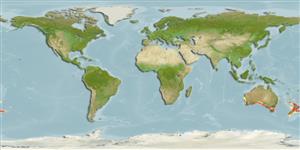Environment: milieu / climate zone / depth range / distribution range
Ecologia
marinhas demersal; intervalo de profundidade 50 - 750 m (Ref. 6390). Subtropical; 26°S - 55°S
Southwest Pacific: Australia and New Zealand. Two forms of ocean perch are recognized in waters off New South Wales, Australia (Ref. 6390). They are referred to as 'inshore' and 'offshore' forms based on their preferred depth ranges (Ref. 6390).
A closely related species, Helicolenus barathri, is known from New Zealand and its distribution may also include southern Australian waters (Ref. 30468, 30471).
Tamanho / Peso / Idade
Maturity: Lm ? range ? - ? cm
Max length : 47.0 cm TL macho/indeterminado; (Ref. 9563); peso máx. publicado: 1.4 kg (Ref. 30476); idade máx. registrada: 42 anos (Ref. 30476)
Descrição suscinta
Chaves de identificação | Morfologia | Morfometria
Espinhos dorsais (total) : 12; Raios dorsais (total) : 11 - 12; Espinhos anais: 3; Raios anais : 5; Vértebras: 25.
Occur on the continental shelf and slope (Ref. 9563). Two forms exist in New South Wales, Australia. The inshore form is dominant in depths less than 300 m and the offshore form is most common in deeper waters (Ref. 30468). Juveniles of both forms are caught near the edge of the continental shelf by fishers targeting royal red prawns (Haliporoides sibogae) in Australia, but their full distribution is unknown (Ref. 6390). Reproduction in ocean perch is distinctive in that fertilization is internal (Ref. 6390, 34817). Feed on squid, shrimps and fish (Ref. 6390). Head and dorsal-fin spines are venomous (Ref. 33616). Sold whole and chilled on the domestic fresh fish markets (Ref. 6390).
Ciclo de vida ou comportamento de acasalamento
Maturidade | Reprodução | Desova | Ovos | Fecundidade | Larvas
Larvae stay within the female fish until they are approximately 1 mm long before they are released into the water (Ref. 6390).
In Australia, the inshore and offshore forms of ocean perch begin mating at different times and there is a difference in the length of their larval development prior to release (Ref. 30468).
Kailola, P.J., M.J. Williams, P.C. Stewart, R.E. Reichelt, A. McNee and C. Grieve, 1993. Australian fisheries resources. Bureau of Resource Sciences, Canberra, Australia. 422 p. (Ref. 6390)
Status na Lista Vermelha da UICN (Ref. 130435: Version 2024-1)
Uso pelos humanos
Pescarias: espécies comerciais
Ferramentas
Relatórios especiais
Baixar XML
Fontes da internet
Estimates based on models
Preferred temperature (Ref.
123201): 10.5 - 16.6, mean 13 °C (based on 72 cells).
Índice de diversidade filogenética (Ref.
82804): PD
50 = 0.5020 [Uniqueness, from 0.5 = low to 2.0 = high].
Bayesian length-weight: a=0.01622 (0.00965 - 0.02725), b=3.12 (2.98 - 3.26), in cm total length, based on LWR estimates for this species & (Sub)family-body (Ref.
93245).
Nível Trófico (Ref.
69278): 3.9 ±0.6 se; based on diet studies.
Resiliência (Ref.
120179): Baixo, tempo mínimo de duplicação da população 4,5 - 14 anos (K=0.11-0.12; tmax=42; Fec=150,000).
Fishing Vulnerability (Ref.
59153): High vulnerability (64 of 100).
Nutrients (Ref.
124155): Calcium = 59 [20, 156] mg/100g; Iron = 1.05 [0.46, 2.21] mg/100g; Protein = 17.9 [16.3, 19.7] %; Omega3 = 0.643 [0.281, 1.641] g/100g; Selenium = 42.5 [18.9, 115.9] μg/100g; VitaminA = 24.5 [8.1, 78.9] μg/100g; Zinc = 0.671 [0.378, 1.054] mg/100g (wet weight);
